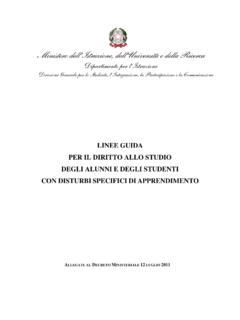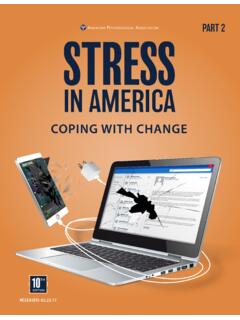Transcription of DOES WORKING FROM HOME WORK? EVIDENCE FROM
1 DOES WORKING FROM home WORK? EVIDENCE FROM. A CHINESE EXPERIMENT*. Nicholas Bloom James Liang John Roberts Zhichun Jenny Ying A rising share of employees now regularly engage in WORKING from home (WFH), but there are concerns this can lead to shirking from home .'' We report Downloaded from at Stanford University on March 3, 2015. the results of a WFH experiment at Ctrip, a 16,000-employee, NASDAQ-listed Chinese travel agency. Call center employees who volunteered to WFH were randomly assigned either to work from home or in the office for nine months. home WORKING led to a 13% performance increase, of which 9% was from work- ing more minutes per shift (fewer breaks and sick days) and 4% from more calls per minute (attributed to a quieter and more convenient WORKING environment). home workers also reported improved work satisfaction, and their attrition rate halved, but their promotion rate conditional on performance fell.
2 Due to the success of the experiment, Ctrip rolled out the option to WFH to the whole firm and allowed the experimental employees to reselect between the home and office. Interestingly, over half of them switched, which led to the gains from WFH almost doubling to 22%. This highlights the benefits of learning and selection effects when adopting modern management practices like WFH. JEL Codes: D24, L23, L84, M11, M54, O31. I. Introduction WORKING from home (WFH; also called telecommuting or tel- ework) is becoming an increasingly common practice. In the United States, the proportion of employees who primarily work *We thank Jennifer Cao, Mimi Qi, and Maria Sun from Ctrip for data, advice, and logistical support. We thank Chris Palauni, David Butler, Jared Fletcher, and Michelle Rowan for their time discussing home WORKING and the call center in- dustries. We thank our formal discussants, Mushfiq Mobarak, Rachael Heath, Sabrina Pabilonia, Shing-Yi Wang, our editors (Larry Katz and Andrei Shleifer).
3 And our four anonymous referees, and numerous seminar audiences for many helpful comments. We thank the National Science Foundation and Toulouse Network for Information Technology (which is supported by Microsoft) for co- funding for this project. No funding was received from Ctrip. James Liang is the co-founder of Ctrip. During the experiment we report here he was nonexecu- tive chairman of Ctrip. Since the end of the experiment he has returned to Ctrip as CEO. No other coauthor has any financial relationship with Ctrip. Neither the results nor the article were prescreened by anyone. The experiment received Stanford University IRB approval. The IRB did not require changes in our exper- imental design. ! The Author(s) 2014. Published by Oxford University Press, on behalf of President and Fellows of Harvard College. All rights reserved. For Permissions, please email: The Quarterly Journal of Economics (2015), 165 218.
4 Advance Access publication on November 20, 2014. 165. 166 QUARTERLY JOURNAL OF ECONOMICS. from home has more than tripled over the past 30 years, from in 1980 to in 2010 (Mateyka, Rapino, and Landivar 2012).1 At the same time, the wage discount (after controlling for observables) from primarily WFH has fallen, from 30% in 1980 to 0 in 2000 (Oettinger 2011). home -based workers now span a wide spectrum of jobs, ranging from sales assistants and realtors to managers and software engineers, with a correspondingly wide range of incomes (Figure I).2. Internationally, WORKING from home also appears to be Downloaded from at Stanford University on March 3, 2015. common. Figure II shows the share of managers allowed to work from home during normal WORKING hours, from a major telephone survey we ran on over 3,000 medium-sized (50 5,000. employee) manufacturing firms during 2012 This is a broader measure of WFH as it covers managers who are allowed to WFH occasionally, for example, one day a week.
5 We find two interesting findings. First, the share of managers in the United States, United Kingdom, and Germany allowed to WFH during normal hours is almost 50%, signaling that this is now a main- stream practice. Second, the share in many developing countries is surprisingly high, at 10% or 20%. Survey respondents from developing countries told us that WFH is becoming increasingly common because of rising traffic congestion and the spread of laptops and cell-phone connectivity. Having employees work from home raises two major issues. First, is it a useful management practice for raising productivity and profitability? This is an important question that lacks system- atic EVIDENCE or consensus. Even within a single industry, practices vary dramatically. For example, at JetBlue Airlines call center em- ployees all work from home , American Airlines does not allow any home work, and United Airlines has a mix of practices.
6 More gen- erally, Bloom, Kretschmer, and Van Reenen (2009) reported wide variation in the adoption rates of managers and employees of WFH. within every three-digit SIC industry code surveyed. 1. This share was 1% in 1990 and in 2000, so has been steadily increasing. 2. Our experiment studies call center employees, who are in lower income deciles, whereas professionals, managers and even academics would be typical of those in the top deciles. Interestingly, the polarization of WFH into top and bottom deciles looks similar to broad employment trends ( , Autor, Katz, and Kearney 2006). 3. These data come from questions included in recent waves of management surveys following the survey protocol outlined in Bloom and Van Reenen (2007) and Bloom et al. (2014). DOES WORKING FROM home WORK? 167. Downloaded from at Stanford University on March 3, 2015. FIGURE I. In the United States WORKING Primarily from home is Relatively More Common for the Highest and Lowest Wage Deciles The figure includes all workers of all ages with positive earnings and more than 20 hours of work per week on average during the last 12 months.
7 Self- employed workers are excluded. We classify workers as WORKING primarily from home if they answer work from home '' to the census question How did you get to work last week?'' Employees are divided into 10 deciles by annual wage. Share of workers WORKING at home is calculated within each wage decile. (Taken from the 2010 American Community Survey sample from IPUMS.). The second issue relates to the concerns over deteriorating work-life balance and the potential of WFH to help address this. The share of households with children in which all parent(s). were WORKING has increased from 40% in 1970 to 62% by 2012. (Council of Economic Advisors 2014). The increasing pressure for parents to work is leading governments in the United States and Europe to investigate ways to promote work-life balance, again with a shortage of EVIDENCE (Council of Economic Advisors, 2010). The efficacy of WFH as a management practice was what con- cerned Ctrip, China's largest travel agency, with 16,000 employees and a NASDAQ listing.
8 Its senior management was interested in allowing its Shanghai call center employees to work from home to reduce office rental costs, which were increasing rapidly due to the booming real estate market in Shanghai. They also thought that allowing WFH might reduce the high attrition rates the firm was experiencing by saving the employees from long commutes. But the managers worried that allowing employees to work at home , 168 QUARTERLY JOURNAL OF ECONOMICS. Downloaded from at Stanford University on March 3, 2015. FIGURE II. WORKING from home (primarily or occasionally) is Common in the United States, Northern Europe, and Even in Many Developing Countries Data from telephone surveys of 3,210 firms randomly picked from the pop- ulation of manufacturing firms with 50 to 5,000 employees (public and privately held firms) following the approach outlined in Bloom and Van Reenen (2007). and Bloom et al.
9 (2014). Plant managers were asked Are managers allowed to work from home during normal WORKING hours?'' Country choice driven by re- search funding and firm population dataset availability. For more details see away from the direct oversight of their supervisors, would lead to a large increase in shirking. The call center workforce was mainly younger employees, many of whom might well have been expected to struggle to remain focused when WFH without direct supervision. Given the uncertainty surrounding the effects of WFH in the research literature as well as in practice, the firm's senior man- agement decided to run a randomized controlled trial. The au- thors assisted in designing the experiment and, essentially whenever feasible, our recommendations were followed by man- agement. We had complete access to the resulting data, as well as to data from surveys conducted by the firm. We also conducted various surveys ourselves and numerous interviews with em- ployees, line supervisors, and senior management.
10 In summary, Ctrip decided to run a nine-month experiment on WFH. They asked the 996 employees in the airfare and hotel DOES WORKING FROM home WORK? 169. departments of the Shanghai call center whether they would be interested in WORKING from home four days a week, with the fifth day in the Approximately half of the employees (503) were interested, particularly those who had less education and tenure, their own rooms, and faced longer commutes. Of these, 249 were qualified to take part in the experiment by virtue of having at least six months' tenure, broadband access, and a private room at home in which they could work. After a lottery draw, those em- ployees with even-numbered birthdays were selected to work Downloaded from at Stanford University on March 3, 2015. from home , and those with odd-numbered birthdates stayed in the office to act as the control group. Office and home workers used the same IT equipment, faced the same work order flow from a common central server, carried out the same tasks, and were compensated under the same pay system, which included an element of individual performance pay.





